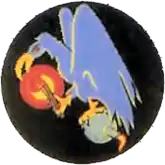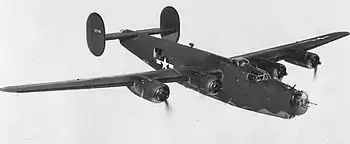814th Troop Carrier Squadron
The 814th Troop Carrier Squadron is an inactive United States Air Force unit. Its last assignment was with 482d Troop Carrier Group stationed at Miami International Airport, Florida.
| 814th Troop Carrier Squadron | |
|---|---|
.jpg.webp) | |
| Active | 1943–1945; 1947–1949; 1952 |
| Country | |
| Branch | |
| Role | Airlift |
| Part of | Continental Air Command |
| Engagements | European Theater of Operations |
| Decorations | Distinguished Unit Citation |
| Insignia | |
| 814th Troop Carrier Squadron emblem (approved 16 October 1944)[1] |  |
During World War II, the squadron was activated in England as the 814th Bombardment Squadron (Pathfinder). Its Consolidated B-24 Liberator aircraft were equipped with first generation radars to guide other bombardment units to targets obscured by cloud cover over Occupied Europe and Nazi Germany, earning a Distinguished Unit Citation in January 1944. In March 1944, it was removed from combat to focus on training pathfinder aircrews and develop tactics, although its developmental work occasionally required it to fly combat missions. After V-E Day, the squadron returned to the United States and was inactivated.
The squadron became a reserve organization, serving as a bombardment unit from 1947–1949 and briefly as an airlift unit in 1952.
History
World War II

VIII Bomber Command's early operations in 1942 and 1943 had shown it that weather conditions in the European Theater of Operations were such that to conduct a successful bombing campaign, the command would need to have the capability of bombing through overcast. Following the Royal Air Force's example, Eighth Air Force formed a group with specially selected aircrews that would act as "Pathfinders", using radar-equipped bombers to lead each wing's bomber formation.[2] The squadron was activated as the 814th Bombardment Squadron, the Consolidated B-24 Liberator squadron of the 482d Bombardment Group on 20 August 1943.[1][3][note 1]
Squadron aircrews were specially selected from all VIII Bomber Command Liberator groups. In addition to its combat mission of acting as Pathfinders, the squadron's mission was to continue the development of tactics and techniques for the use of radar navigation and bombing systems and training crews of other bomber units as Pathfinders.[2] The squadron flew its first mission on 27 September 1943 against port facilities at Emden, although it did not fly as a unit. Rather, its crews and airplanes dispersed to bases of 2d Bombardment Division to lead other group formations. The squadron earned a Distinguished Unit Citation for an 11 January 1944 mission leading bombers to targets such as aircraft factories in central Germany. Although weather prevented effective fighter protection against enemy aircraft, the group bombed assigned targets and destroyed many enemy airplanes. During Big Week attacks it led raids on aircraft factories at Gotha, Braunschweig and Schweinfurt.[3]
In addition to flying pathfinder missions, the squadron trained crews from other groups of VIII Bomber Command. Although it was formally withdrawn from combat in March 1944, it continued to fly occasional missions to test tactics and equipment.[2] In addition, the squadron performed radar photographic mapping of parts of France, the Low Countries, and Germany for training and briefing combat crews.[3] It changed the "Pathfinder" in its name to "Heavy" in November 1944.[3]
The squadron's aircraft left England for the United States between 27 and 30 May 1945. The ground echelon sailed on the RMS Queen Elizabeth from Gourock, Scotland on 24 June 1945.[2] The squadron regrouped at Victorville Army Air Field, California on 5 July 1945, but was inactivated on 1 September 1945.[3]
Reserve operations
The squadron was redesignated the 814th Bombardment Squadron, Very Heavy and activated in the reserve at New Orleans Municipal Airport on 9 September 1947.[1] Although nominally a bomber unit, it is not clear whether the squadron had any operational aircraft assigned, or if it was fully manned. Continental Air Command, which was responsible for training reserve and Air National Guard units, reorganized its reserve units under the wing base organization system in June 1949.[4] President Truman’s 1949 defense budget also required reductions in the number of units in the Air Force, so reserve flying operations at New Orleans Municipal Airport ceased and the 814th was inactivated in this reorganization.[1][5]
All reserve combat organizations had been mobilized for the Korean War,[6] and it was not until the summer of 1952 that reserve units again began receiving aircraft.[7] The squadron was redesignated the 814th Troop Carrier Squadron and activated at Miami International Airport, Florida on 14 June 1952, when the 482d Troop Carrier Wing replaced the 906th Reserve Training Wing, which had supervised reserve operations there since 1951. The squadron trained with Curtiss C-46 Commandos under the supervision of the 2585th Air Force Reserve Training Center.[8] In December 1953, the 435th Troop Carrier Wing at Miami was released from active duty and assumed the mission, personnel and equipment of the 482d Wing. In this reorganization, the 78th Troop Carrier Squadron took over the mission, personnel and aircraft of the 814th, which was inactivated.[1][9][note 2]
Lineage
- Constituted as the 814th Bombardment Squadron (Pathfinder) on 10 August 1943
- Activated on 20 August 1943
- Redesignated 814th Bombardment Squadron, Heavy on 11 November 1944
- Inactivated on 1 September 1945
- Redesignated 814th Bombardment Squadron, Very Heavy on 13 August 1947
- Activated in the reserve on 9 September 1947
- Inactivated on 27 June 1949
- Redesignated 814th Troop Carrier Squadron, Medium on 26 May 1952
- Activated in the reserve on 14 June 1952
- Inactivated on 1 December 1952[1]
Assignments
- 482d Bombardment Group, 20 August 1943 – 1 September 1945
- 482d Bombardment Group, 24 September 1947 – 27 June 1949
- 482d Troop Carrier Group, 14 June-1 December 1952[1]
Stations
- RAF Alconbury, England, 20 August 1943-June 1945
- Victorville Army Air Field, California, July-1 September 1945
- Harding Field, Louisiana, 24 September 1947 – 27 June 1949
- Miami International Airport, Florida, 14 June-1 December 1952[1]
Aircraft
- Consolidated B-24 Liberator, 1943–1945
- Curtiss C-46 Commando, 1952[1]
Awards and campaigns
| Award streamer | Award | Dates | Notes |
|---|---|---|---|
| Distinguished Unit Citation | 11 January 1944 | Germany, 814th Bombardment Squadron[1] |
| Campaign Streamer | Campaign | Dates | Notes |
|---|---|---|---|
| Air Offensive, Europe | 20 August 1943–5 June 1944 | 814th Bombardment Squadron[1] | |
| Normandy | 6 June 1944–24 July 1944 | 814th Bombardment Squadron[1] | |
| Northern France | 25 July 1944–14 September 1944 | 814th Bombardment Squadron[1] | |
| Rhineland | 15 September 1944–21 March 1945 | 814th Bombardment Squadron[1] | |
| Central Europe | 22 March 1944–21 May 1945 | 814th Bombardment Squadron[1] |
References
Notes
- Explanatory noted
- The group also had two squadrons flying Boeing B-17 Flying Fortresses. Maurer, Combat Squadrons, pp. 763–765.
- Although it had been mobilized in 1951, the 435th Wing remained in Miami as a training organization for C-46 crews deploying to the Far East. Ravenstein, p. 231. When it was released from active duty on 1 December 1952, its resources were taken over by the newly-activated 456th Troop Carrier Wing, while it took over those of the 482d. Ravenstein, pp. 231, 251, 268.
- Citations
- Maurer, Combat Squadrons, p. 765
- Freeman, p. 260
- Maurer, Combat Units, pp. 352–354
- Endicott, Judy G. (28 December 2007). "Factsheet 482 Operations Group (AFRC)". Air Force Historical Research Agency. Retrieved 29 July 2016.
- Knaack, p. 25
- Cantwell, p. 87
- Cantwell, p. 139
- Ravenstein, pp. 267–268
- See Maurer, Combat Squadrons, p. 276 (simultaneous activation of the 76th Squadron).
Bibliography
![]() This article incorporates public domain material from the Air Force Historical Research Agency website http://www.afhra.af.mil/.
This article incorporates public domain material from the Air Force Historical Research Agency website http://www.afhra.af.mil/.
- Cantwell, Gerald T. (1997). Citizen Airmen: a History of the Air Force Reserve, 1946–1994. Washington, D.C.: Air Force History and Museums Program. ISBN 0-16049-269-6. Retrieved 17 December 2016.
- Freeman, Roger A. (1970). The Mighty Eighth: Units, Men and Machines (A History of the US 8th Army Air Force). London, England, UK: Macdonald and Company. ISBN 978-0-87938-638-2.
- Knaack, Marcelle Size (1978). Encyclopedia of US Air Force Aircraft and Missile Systems (PDF). Vol. 2, Post-World War II Bombers 1945-1973. Washington, DC: Office of Air Force History. ISBN 0-912799-59-5. Retrieved 17 December 2016.
- Maurer, Maurer, ed. (1983) [1961]. Air Force Combat Units of World War II (PDF) (reprint ed.). Washington, DC: Office of Air Force History. ISBN 0-912799-02-1. LCCN 61060979. Retrieved 17 December 2016.
- Maurer, Maurer, ed. (1982) [1969]. Combat Squadrons of the Air Force, World War II (PDF) (reprint ed.). Washington, DC: Office of Air Force History. ISBN 0-405-12194-6. LCCN 70605402. OCLC 72556. Retrieved 17 December 2016.
- Ravenstein, Charles A. (1984). Air Force Combat Wings, Lineage & Honors Histories 1947-1977. Washington, DC: Office of Air Force History. ISBN 0-912799-12-9. Retrieved 17 December 2016.